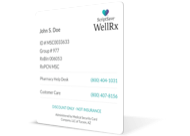Copyright 2024
Medical Security Card Company, LLC
All Rights Reserved
WellRx will never sell your personal information. Period. By signing up I agree to WellRx's terms of use and privacy policy.
James Ketterer, PharmD
May 24, 2017
Statins are a class of drugs used to lower cholesterol and decrease the risk of cardiovascular events. They work by inhibiting an enzyme from completing an early step in the body’s process of synthesizing cholesterol. Statins are among the most commonly prescribed medications in the country. Approximately 1-2% of patients on statins report experiencing muscle pain. This pain can present itself in a variety of ways but most often results in flu-like aches and pains. The muscles may feel stiff or sore like the feeling after working out. This usually effects the larger muscles of the body such as parts of the back or thighs. This side effect is often responsible for patients discontinuing the use of these drugs.
Do statins cause muscle pain? The exact cause of this phenomenon is not completely understood, but many researchers have hypothesized that vitamin D levels may play a role. Vitamin D is mainly produced in the skin from sun exposure. However, this source is not active. The liver and kidneys are responsible for activating the vitamin D which then plays a role in facilitating intestinal absorption of essential nutrients as well as balancing bone health homeostasis. Vitamin D deficiencies often present with similar muscle pain as those found as a side effect in statins.
Some researchers have theorized that statins could reduce vitamin D levels because certain types of cholesterol carry vitamin D and when the cholesterol is reduced, less vitamin D could be transported. On the other hand, many have theorized that since both vitamin D and statins are metabolized by the same enzyme in the liver, the use of statins could delay metabolism of vitamin D, thus increasing levels in the blood.
Clinical trials and various other studies and reports have yielded mixed results on muscle pain in statin users with low compared to high levels of vitamin D. A large analysis of these trials showed that more studies resulted in statin users having higher levels of vitamin D on average. One retrospective study divided statin users into 4 groups, 1 being the lowest vitamin D levels and 4 being the highest. Group 1 was 1.21 times more likely to develop muscle pain than group 4. Another study showed statin users with vitamin D levels of less than 15 ng/mL were 1.9 times more likely to experience muscle pain compared with non-statin users. The statin users with higher levels of vitamin D did not have higher risk for muscle pain compared with non-statin users.
When a patient experiences what is believed to be the side effect of a drug, they are often taken off of the drug to see if the symptoms resolve. If they do resolve, sometimes the patient is started back on the drug to see if the symptoms return. This a referred to as a “rechallenge”. One chart review showed that returning vitamin D levels to a sufficient level before a rechallenge in statin users who had experienced muscle pain, increased their tolerability to statins.
Some studies have given vitamin D supplements to statin users experiencing muscle pain. While these studies were uncontrolled, they did show improvement in muscle pain in nearly 90% of patients.
These are just a few of the examples of research looking at the correlation between stain use and vitamin D levels as a possible cause of muscle pain. While nothing is definitive at this point, patients on statins that are experiencing muscle pain may want to explore vitamin D supplementation as a possible resolution plan. The benefits of statins are well documented in patients with heart risks. Any side effects should be attempted to be overcome before giving up on the statin and assuming it is the cause.
References:
Gregory, Philip J. ” Vitamin D and Statin-Related Myalgia”. Medscape. 2017. Web. 10 Mar. 2017.
Simvastatin. Micromedex Solutions. Truven Health Analytics, Inc. Ann Arbor, MI. Available at: https://www.micromedexsolutions.com. Accessed March 20, 2017.

For your convenience, use the ScriptSave® WellRx mobile app. Now savings are well in hand, right at the pharmacy counter. Save on your family's prescription medicines.
Learn More
Your choice. Get a ScriptSave WellRx Savings Card. Or Download the free mobile app from the App Store or Google Play Store
Get A Card
ScriptSave WellRx Grocery Guidance leverages leading-edge nutritional data science to help you know which food products on your grocery store shelf are truly good for YOU.
Healthy Foods For YouTags:

June 09, 2022

April 26, 2022
You need to log into the site to use this feature
This feature requires registration. Sign up or log in to your free WellRx account to gain access to this and other tools to help make managing your medications and wellness easier.
Benefits Include:
 Store & manage your medication list
Store & manage your medication list
 Medication pricing updates
Medication pricing updates
 Medication information
Medication information
 Pill & refill reminders
Pill & refill reminders
 Medication journal & mood log
Medication journal & mood log
This feature requires registration. Sign up or log in to your free WellRx account to gain access to this and other tools to help make managing your medications and wellness easier.
Benefits Include:
 Store & manage your medication list
Store & manage your medication list
 Medication pricing updates
Medication pricing updates
 Medication information
Medication information
 Pill & refill reminders
Pill & refill reminders
 Medication journal & mood log
Medication journal & mood log
You will be redirected to your program in 5 seconds.
Our Terms and Conditions and Privacy Policy have recently been updated.
By declining you will be logged out of your account